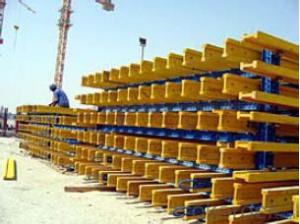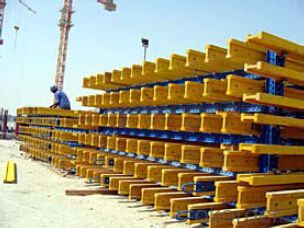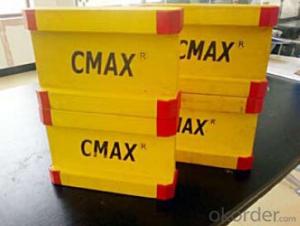Timber-beam Plywood Formwork for building Construction
- Loading Port:
- Tianjin
- Payment Terms:
- TT OR LC
- Min Order Qty:
- 50 m²
- Supply Capability:
- 1000 m²/month
OKorder Service Pledge
Quality Product, Order Online Tracking, Timely Delivery
OKorder Financial Service
Credit Rating, Credit Services, Credit Purchasing
You Might Also Like
Plywood --- make perfect concrete surface
WISA-Form Birch is a coated special plywood using in the formwork systems where high
requirements are set on the concrete surface and the times of reuses.
With CNBM timber beam & WISA plywood, the formwork is low weight but high load capacity, it is
widely used in construction.
Characteristics:
◆ Component with high standardization.
◆ Assembling in site, flexible application.
◆ Light weight, easy transportation and storage.

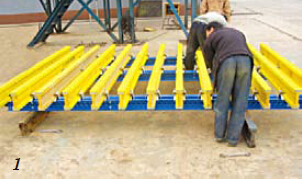
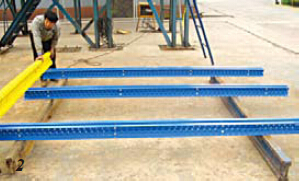
- Q: Is steel formwork resistant to fire?
- Yes, steel formwork is generally resistant to fire. Steel itself has a high melting point and does not easily ignite or contribute to the spread of fire. In the case of steel formwork, it is typically designed and manufactured to withstand high temperatures without deformation or structural failure. This makes it a suitable choice for construction projects that require fire-resistant materials. Additionally, steel formwork can also provide better fire protection for the concrete being poured into it, as concrete has inherent fire-resistant properties. However, it is important to note that the fire resistance of steel formwork can also depend on factors such as the thickness of the steel, the design of the formwork, and the fire protection measures in place at the construction site. It is always advisable to consult with professionals and follow appropriate fire safety regulations and guidelines when using steel formwork in construction projects.
- Q: How does steel formwork handle moisture and humidity?
- Due to its inherent properties and effective protective measures, steel formwork exhibits high resistance to moisture and humidity. Typically, the steel utilized in formwork construction undergoes treatment with anti-corrosion coatings like galvanization or epoxy paint. These coatings establish a barrier that hinders moisture penetration, thus safeguarding the steel from water's corrosive effects, preventing rust formation, and averting structural degradation. Moreover, steel formwork systems are meticulously designed with tight joints and connections to minimize water ingress. This reduces the likelihood of moisture accumulation within the formwork, which could potentially compromise the structure's strength or impact the concrete's quality. Furthermore, steel formwork possesses a non-absorbent characteristic, meaning it does not absorb water or humidity. This attribute prevents swelling, warping, or distortion of the formwork caused by exposure to moisture. It also guarantees consistent and accurate formwork dimensions, resulting in precise concrete shapes and finishes. In scenarios where steel formwork is subjected to elevated levels of moisture or humidity, such as in marine or coastal environments, additional protective measures can be implemented. These measures may involve the application of specialized coatings or the utilization of stainless steel formwork, which offers superior resistance to corrosion and moisture. Overall, steel formwork is highly suitable for managing moisture and humidity. Its resistance to corrosion, non-absorbent nature, and ability to maintain structural integrity even in challenging environmental conditions make it a dependable and long-lasting choice for construction projects.
- Q: How does steel formwork handle concrete consolidation and compaction?
- Steel formwork is highly suitable for concrete consolidation and compaction due to its durability and rigidity. The strong and rigid nature of steel formwork allows it to withstand the pressure exerted during concrete pouring and compaction. Additionally, steel formwork provides a smooth surface that facilitates proper consolidation and compaction of concrete, resulting in a high-quality finished product.
- Q: What are the common design considerations for steel formwork in tunnel construction?
- There are several common design considerations for steel formwork in tunnel construction. Firstly, the design should take into account the load-bearing capacity of the formwork. The formwork needs to be strong enough to withstand the weight of the concrete and any additional loads that may be applied during the construction process. This includes considering factors such as the depth and length of the tunnel, as well as the type of soil and water pressure that may be present. Secondly, the design should ensure that the formwork is able to withstand the lateral pressure exerted by the wet concrete. This often requires the use of lateral support systems, such as tie rods or bracing, to prevent the formwork from buckling or deforming under the pressure. Another important consideration is the ease of assembly and disassembly of the formwork. Tunnel construction often involves tight spaces and difficult access, so the formwork should be designed in a way that allows for efficient installation and removal. This may involve using modular components or adjustable systems that can be easily adapted to the specific dimensions and shape of the tunnel. Additionally, the design of the formwork should take into account the surface finish requirements of the tunnel. Depending on the intended use of the tunnel, a smooth and uniform concrete surface may be necessary. The formwork design should ensure that the concrete is properly supported and that any necessary form liners or finishes can be easily installed and maintained. Finally, the design should consider the safety of the construction workers. This includes providing adequate fall protection measures, such as guardrails or safety nets, as well as ensuring that the formwork is stable and secure during the construction process. This may involve incorporating features such as adjustable legs or base plates to ensure proper stability on uneven surfaces. Overall, the common design considerations for steel formwork in tunnel construction involve load-bearing capacity, lateral pressure resistance, ease of assembly and disassembly, surface finish requirements, and worker safety. By addressing these considerations, the formwork design can contribute to the successful and efficient construction of tunnels.
- Q: Can steel formwork be used in areas with high chemical exposure?
- While steel formwork can be utilized in areas characterized by high levels of chemical exposure, it may not necessarily be the most optimal selection. Although steel is generally recognized as a resilient and robust substance, it is prone to corrosion upon encountering specific chemicals. In situations where the chemicals prevalent within the vicinity are known to induce corrosion in steel, it is advisable to contemplate alternative formwork materials like plastic or aluminum, which possess a higher resistance to chemical exposure. Moreover, it is feasible to enhance the steel formwork's chemical resistance by applying protective coatings or treatments. Nonetheless, it is crucial to thoroughly assess the particular chemicals and their concentration within the area in order to ascertain the most suitable formwork material for the project.
- Q: How does steel formwork compare to aluminum formwork in terms of cost?
- Compared to aluminum formwork, steel formwork generally tends to be more expensive in terms of cost. This is because steel is a stronger and more durable material, leading to higher production and material costs. Additionally, due to its heavier weight, steel formwork requires more labor for handling and installation. On the other hand, aluminum formwork is lighter and easier to handle, reducing labor costs and increasing construction efficiency. Furthermore, aluminum formwork can be reused multiple times, resulting in significant cost savings for multiple projects. In summary, steel formwork offers superior strength and durability but comes with a higher initial cost compared to aluminum formwork, considering material and labor factors.
- Q: What are the considerations when designing steel formwork for industrial facilities?
- When designing steel formwork for industrial facilities, there are several important considerations that need to be taken into account. These considerations include: 1. Load-bearing capacity: Industrial facilities often house heavy machinery and equipment, so the steel formwork needs to be designed to withstand the weight and load placed on it. The formwork should be able to support the weight of the machinery while ensuring structural stability and safety. 2. Durability: Steel formwork should be able to withstand the harsh conditions often found in industrial facilities, such as temperature fluctuations, exposure to chemicals or corrosive substances, and heavy usage. It should be designed to have a long lifespan and require minimal maintenance to ensure cost-effectiveness. 3. Flexibility and adaptability: Industrial facilities often undergo changes, upgrades, or modifications over time. Therefore, the steel formwork should be designed to be flexible and adaptable, allowing for easy modifications or additions as required. This includes considering factors such as future expansion, reconfiguration, or relocation of machinery or equipment. 4. Safety: Safety is a crucial consideration when designing steel formwork for industrial facilities. The formwork should be designed to prevent accidents or injuries, such as by incorporating safety features like guardrails, non-slip surfaces, or adequate lighting. It should also adhere to relevant safety codes and standards to ensure compliance. 5. Ease of construction and dismantling: Steel formwork should be designed to be easily assembled and disassembled. This will not only save time during construction but also allow for efficient reusability of the formwork in future projects. Considerations like modular designs or prefabricated components can facilitate easier construction and dismantling processes. 6. Cost-effectiveness: Designing steel formwork for industrial facilities should also take into account cost-effectiveness. This includes optimizing material usage, minimizing waste, and considering the long-term maintenance and operational costs. Balancing the initial investment with the expected lifespan and benefits of the formwork is essential to achieve the most cost-effective solution. Overall, designing steel formwork for industrial facilities requires careful consideration of load-bearing capacity, durability, flexibility, safety, ease of construction, and cost-effectiveness. By addressing these considerations, designers can ensure that the formwork meets the specific requirements of industrial applications and provides a reliable and efficient solution for construction projects.
- Q: How does steel formwork affect the overall dimensional stability of a structure?
- Steel formwork can significantly impact the overall dimensional stability of a structure in a positive manner. Due to its inherent strength and rigidity, steel formwork provides excellent support during the construction process, ensuring accurate and precise concrete placement. This results in a structure with improved dimensional stability as the steel formwork helps to maintain the designed shape and dimensions. The use of steel formwork offers several advantages that contribute to the overall dimensional stability. Firstly, steel is known for its high strength-to-weight ratio, which allows for the creation of sturdy and durable formwork systems. This strength translates into better resistance against deformation, preventing any shifts or movements in the formwork during concrete pouring. As a result, the final structure is less likely to experience dimensional changes, ensuring the desired shape and dimensions are maintained. Additionally, steel formwork provides superior dimensional accuracy compared to other formwork materials. Steel plates or panels used in the formwork can be manufactured with high precision, resulting in consistent dimensions and smooth surfaces. This precision eliminates any inconsistencies or irregularities that may arise from using traditional formwork materials like wood or plywood, further enhancing the overall dimensional stability of the structure. Moreover, steel formwork is highly resistant to moisture, humidity, and temperature variations, which can often lead to dimensional changes in other materials. Steel's resistance to these factors ensures that the formwork remains stable and retains its original shape, even under challenging environmental conditions. This stability extends to the concrete poured within the formwork, as the steel helps to minimize shrinkage and expansion, thereby reducing the risk of cracking or warping in the structure. In conclusion, steel formwork plays a crucial role in maintaining the overall dimensional stability of a structure. Its strength, precision, and resistance to environmental factors ensure that the formwork remains intact and supports the concrete placement accurately. By providing a reliable and robust framework, steel formwork allows for the creation of structures with enhanced dimensional stability, resulting in a more durable and long-lasting final product.
- Q: How does steel formwork contribute to better site organization?
- Steel formwork contributes to better site organization by providing a durable and reusable system for creating concrete structures. Its accuracy, strength, and ease of assembly allow for efficient and precise construction, reducing the need for on-site adjustments or modifications. This results in a well-organized and streamlined construction process, saving time and resources. Additionally, steel formwork's versatility enables the creation of complex shapes and designs, enhancing the aesthetic appeal of the site.
- Q: How does steel formwork handle different concrete surface gloss levels?
- Steel formwork is a versatile and durable option for dealing with different levels of gloss on concrete surfaces. Its ability to create a consistent and even finish is due to its smooth and rigid nature. When it comes to achieving different levels of gloss on concrete surfaces, steel formwork has several advantages. Firstly, it offers a smooth and uniform surface, which is crucial for achieving a high gloss finish. The steel panels are meticulously constructed to create a seamless surface, minimizing any irregularities that could affect the desired gloss level. In addition, steel formwork is highly resistant to warping or bending under the weight of the concrete. This ensures that the surface remains level and consistent, which is particularly important when aiming for a glossy finish. Any inconsistencies in the formwork could lead to uneven concrete placement and variations in gloss. Moreover, steel formwork is reusable, making it cost-effective and environmentally friendly. With proper maintenance and care, it can be used for multiple projects, ensuring consistent results in terms of gloss levels. In conclusion, steel formwork is an excellent choice for handling different levels of gloss on concrete surfaces. Its smooth and rigid construction guarantees a uniform finish, while its durability ensures consistent results. Steel formwork provides an efficient and effective solution for achieving various gloss levels in concrete construction projects.
Send your message to us
Timber-beam Plywood Formwork for building Construction
- Loading Port:
- Tianjin
- Payment Terms:
- TT OR LC
- Min Order Qty:
- 50 m²
- Supply Capability:
- 1000 m²/month
OKorder Service Pledge
Quality Product, Order Online Tracking, Timely Delivery
OKorder Financial Service
Credit Rating, Credit Services, Credit Purchasing
Similar products
Hot products
Hot Searches
Related keywords

